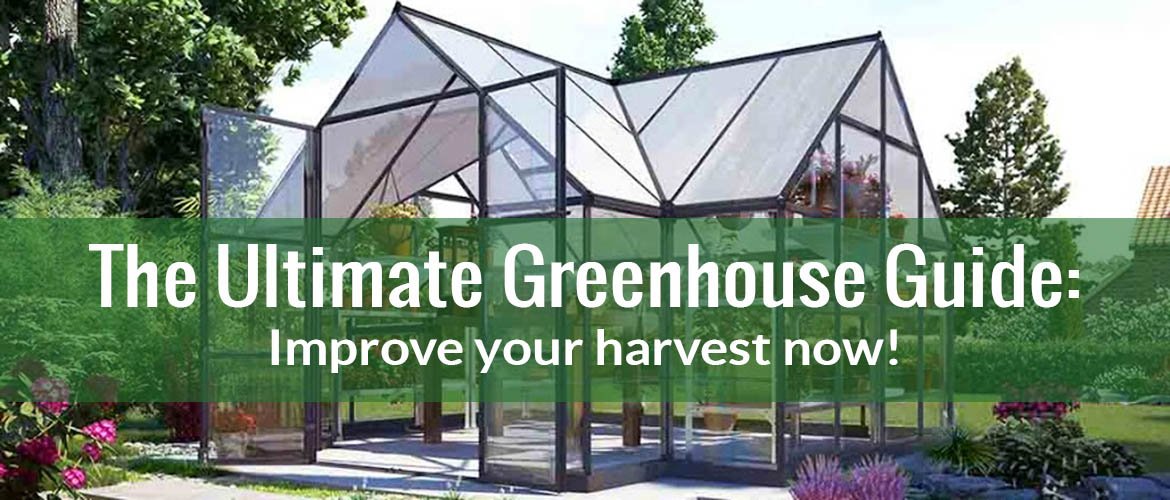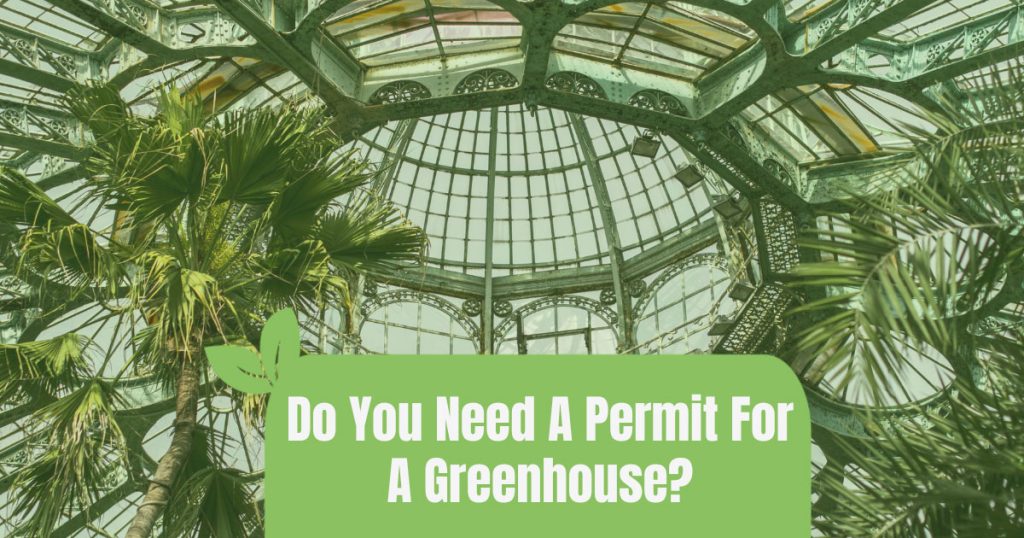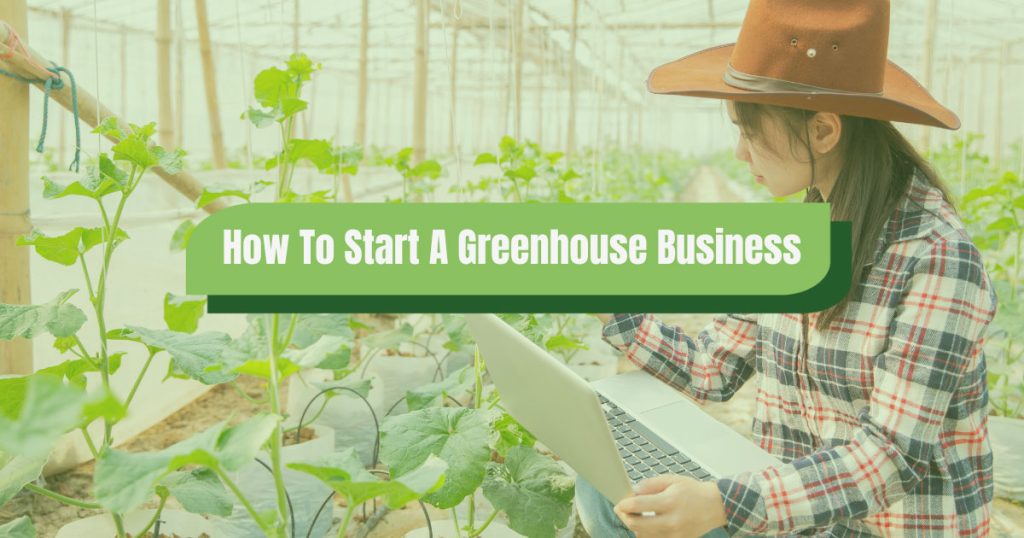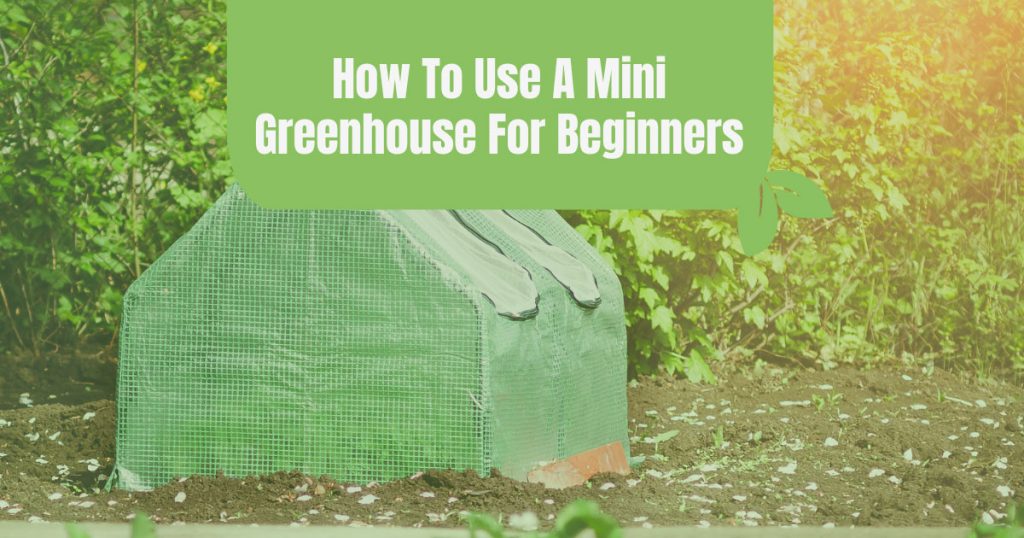If you already enjoy growing fresh veggies and fruits in your garden during the growing season, you might want to bring it to the next level by growing year-round in a greenhouse.
However, there are many things to consider before getting a greenhouse: What type of greenhouse is the best choice for me?, What size do I need?, Where should I place it? and so on. This guide will help you with all these questions so that you will have an easier start with greenhouse gardening.
Benefits of growing a greenhouse
Greenhouse gardening has many benefits and only two disadvantages: You have to put time and money into it. In return, you can enjoy the following benefits:
Longer growing season
A greenhouse stretches the growing season so that you can either start growing earlier every year or you can actually grow your plants year-round. This is especially interesting for people, who live in colder climates.
The structure of a greenhouse uses the heat of the sun to increase the temperature inside the greenhouse. So the inside temperature is always higher than outside. This way you can even enjoy your tomatoes during the fall and winter months.
Plant isolation
A greenhouse means protection for your plants. While your outside crops are at the mercy of insects and rodents, you don’t have to worry about this with a greenhouse. In the garden, your plants are exposed to insects, rodents, and other animals, as well as diseases. A greenhouse can provide isolation and, therefore, protection.
Protection from the elements
Storm, hail, wind, heavy rain, or even drought cannot harm your plants because they are protected by the sturdy structure of a greenhouse. Just like your house provides security from the weather, a greenhouse does the same for your plants.
It’s a carefree way of gardening because unforeseen weather changes won’t damage your crops.
Saving on grocery bills
If you don’t have a garden and grow your own veggies and fruits, you most likely spend a lot more money in grocery stores or farmer’s markets. A greenhouse gives you room to grow for a longer time in the year. This means you don’t have to spend the money in supermarkets to get mediocre veggies and of course veggies from your own garden always taste better.

Control overproduce
At the same time, you will have full control over your plants. This means you know what chemicals you are using or not using.
Studies have shown that vegetables and fruits have chemical residues and some of these pesticides have already been banned in the U.S., and yet they still are used in some areas.
In your own greenhouse, you can decide what is best for you and your family. You can learn how to use organic pest control in case you really need it.
Multipurpose
Vegetables, fruits, herbs, and flowers – a greenhouse can be used for any kind of plant. Since you can use bed separators, shelves, and tables, you can even vary the soil to make the most out of your own greenhouse.
Some greenhouse designs also make it an excellent place for social events. A nice Sunday’s brunch next to your strawberry plants and citrus trees in an Orangerie could be your new family ritual.
What are the different greenhouse types?
We know it can be overwhelming when you browse through different internet sources and see different types of greenhouses. We want to make it easy for you by providing the most common names, terms, and structures.
Greenhouse types by purpose
One big factor in choosing the right greenhouse is the purpose of use. Manufacturers designed different greenhouses according to the usage of them. So they can offer the perfect greenhouses for different ways of life.
Hobby greenhouses
A hobby greenhouse most likely is the one that you are looking for. It’s the place for hobby gardeners to grow their plants in a secured and controlled environment. A hobby greenhouse is an overall term for “non-professional” gardeners, who grow vegetables and other plants for their family in a greenhouse.
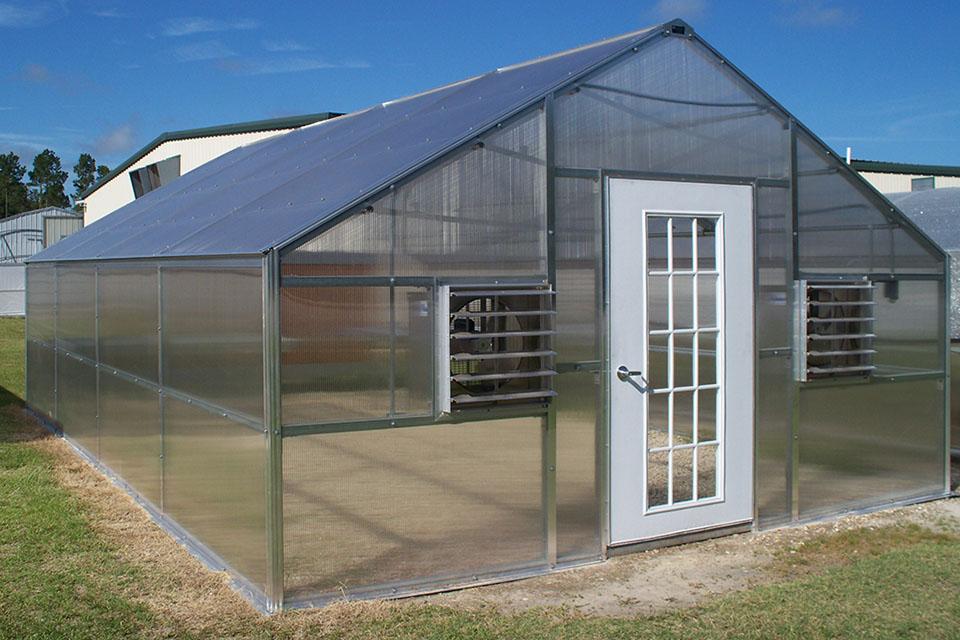
Commercial greenhouses
In contrast to the hobby greenhouse, this type of greenhouse is for professionals, who grow plants for a commercial use, i.e. farmers.
They usually are bigger and have some additional features for growing at a large scale.
Educational greenhouses
The name already reveals its purpose. Educational greenhouses are made for schools, universities, and other educational institutions. These greenhouse kits are for education and therapy.
Conservatories
Conservatories are greenhouses that have a shared purpose. While people still grow plants, they use them for social happenings at the same time.
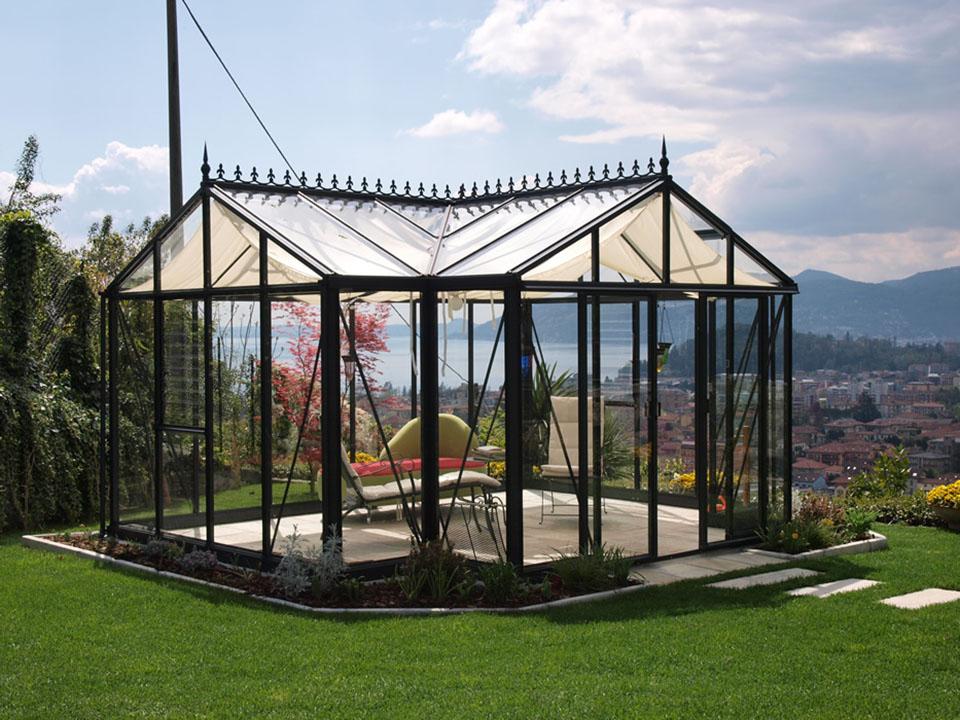
They mostly are freestanding greenhouses. Some cities have them as a recreational attraction for visiting. Conservatories have been very popular in the nineteenth century when tea parties were held in them to enjoy the great atmosphere of citrus trees. It’s a nice place to escape the winter.
Cold greenhouses and cold frames
In winter, the temperatures can drop quite extremely, even inside a cold greenhouse. It doesn’t use an alternate heating source and it isn’t as insulated as hot greenhouses.
Cold frames or cold greenhouses are good for getting started earlier in the growing season and extending it into fall. However, they are still limited by the weather.
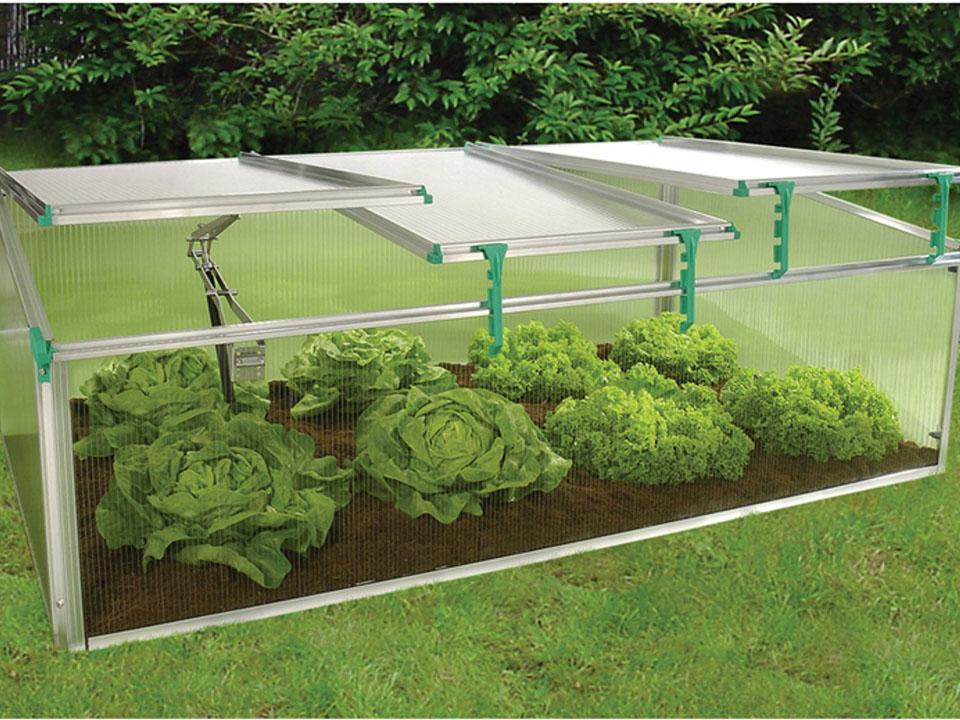
Cool greenhouses
In a cool greenhouse, the temperature stays above freezing (45–50 °F) so that your plants will be protected over the winter. This makes it perfect for flowers and plants that aren’t winter-proof, such as hyacinths and geraniums.
Warm greenhouses
With 50–55 °F, a warm greenhouse provides a protective space for plants that are sensitive to low temperatures, such as orchids, chrysanthemums, and roses. However, this will not secure tropical plants.
Hot greenhouses or hothouses
In hothouses, you will have temperatures starting at 60°F and higher, which makes it perfect for tropical plants and year-round growing.
Want to read more about the different temperatures inside a greenhouse? Read this.
Freestanding greenhouses
In this section, you will learn more about outdoor greenhouses that can stand in your backyard. The freestanding greenhouses are all structures that are not connected to a wall or house.
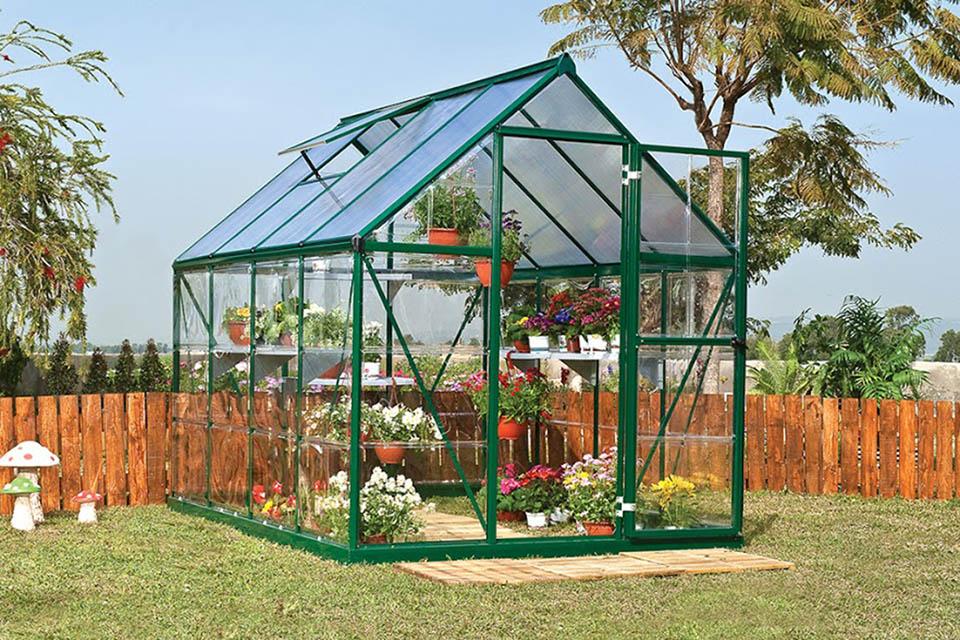
Conventional greenhouse
When you think of a greenhouse, a gable roof design will pop up in your mind. The conventional greenhouse looks like a simple house made of glass or Polycarbonate. It has a simple, but solid structure.
It is one of the most popular structures. It offers a lot of room to grow your plants efficiently.
A-frame greenhouse
The name already tells you what shape an A-frame greenhouse is. This triangular house uses the minimal amount of materials. Besides the hoop house, it is one of the most common greenhouse structures for DIY projects.
However, it has its limits in the functionality as it is pretty narrow and air flow can become a problem in corners.
Hoop house
The hoop house is shaped like a half of a hoop, which is the origin of its name. The support comes from aluminum or plastic pipes that are often covered in one or two layers of polymer plastic.
With costs of less than $1 per square foot, the hoop house is considered one of the cheapest greenhouse constructions.
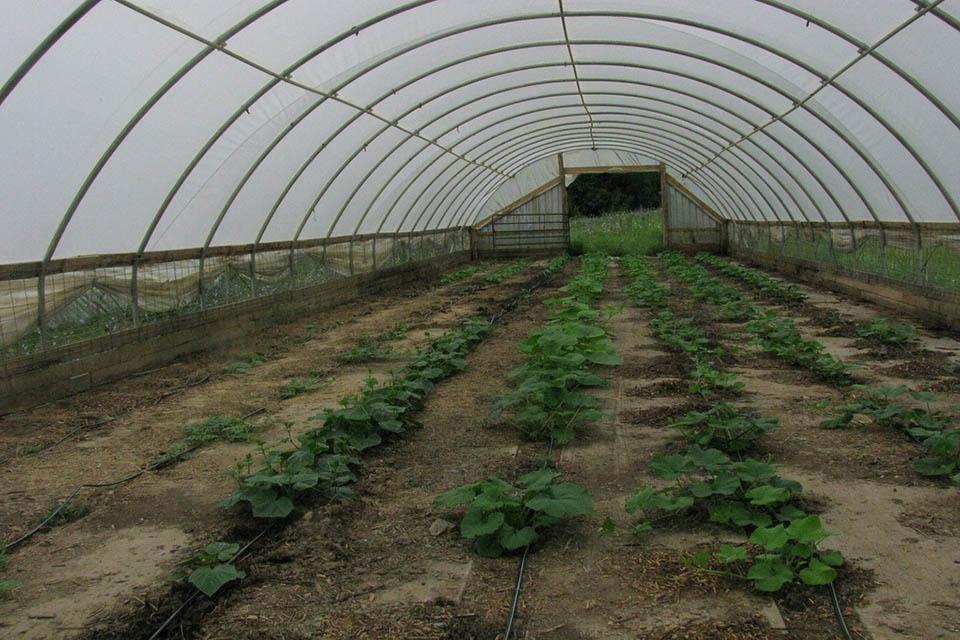
Quonset house
Another popular style for greenhouses is the Quonset. The hoop house basically can be considered a Quonset because it has the same shape.
Compared to the A-frame, the Quonset offers more room to move inside the greenhouse.
Gothic arch or onion-shaped greenhouse
The shape of the Gothic arch greenhouse is similar to the Quonset house but has a pointed top. So it looks like the pointed tip of a water drop or an onion.
The benefits of a Gothic arch greenhouse are that they enable good light transmission and a lot of room. They are also perfect for areas with lots of snow and wind.
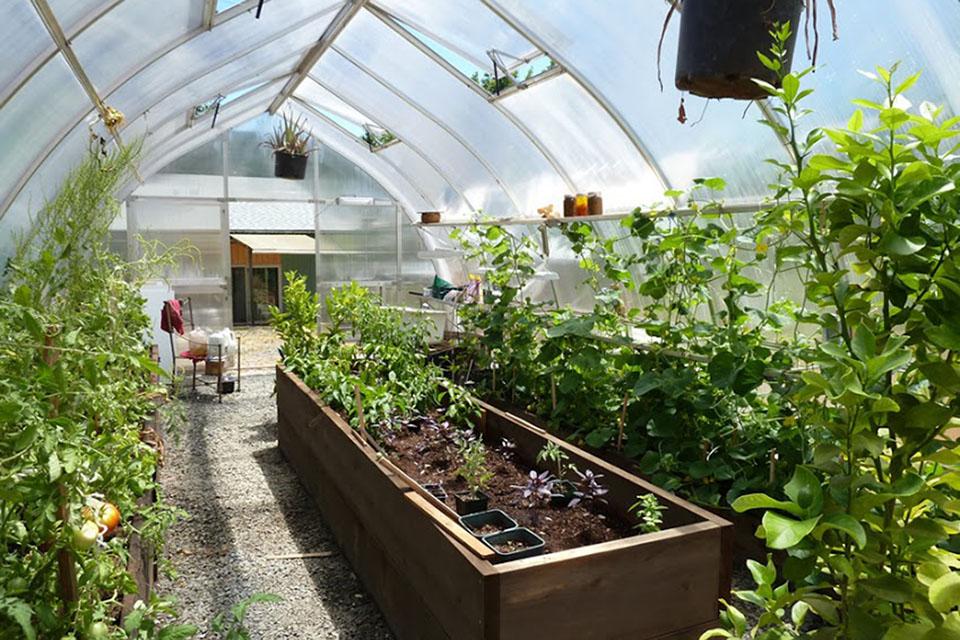
Victorian greenhouse
Victorian greenhouses were very common in the nineteenth century and symbolized wealth and status quo. They were far more than a house for gardening.
A Victorian greenhouse was rather used as a green social meeting point. The design is practical as well as artistic. So it stands out against the other greenhouse structures.
Geodesic Dome Greenhouse
A Geodesic Dome greenhouse is constructed like a dome by using triangular shapes. It needs precise angles and measurements. The structure is very strong and can withstand all weathers, including tornadoes and earthquakes.
Geodesic Dome greenhouses have a high energy efficiency and a better light transmission than conventional greenhouses. Read more…

Read more about the different shapes and structures of greenhouses in this article!
Attached greenhouses
Besides the freestanding greenhouses, there are also greenhouse structures that can be attached to your house or window. It’s a great solution for people, who don’t have a large backyard and want to use their space efficiently.
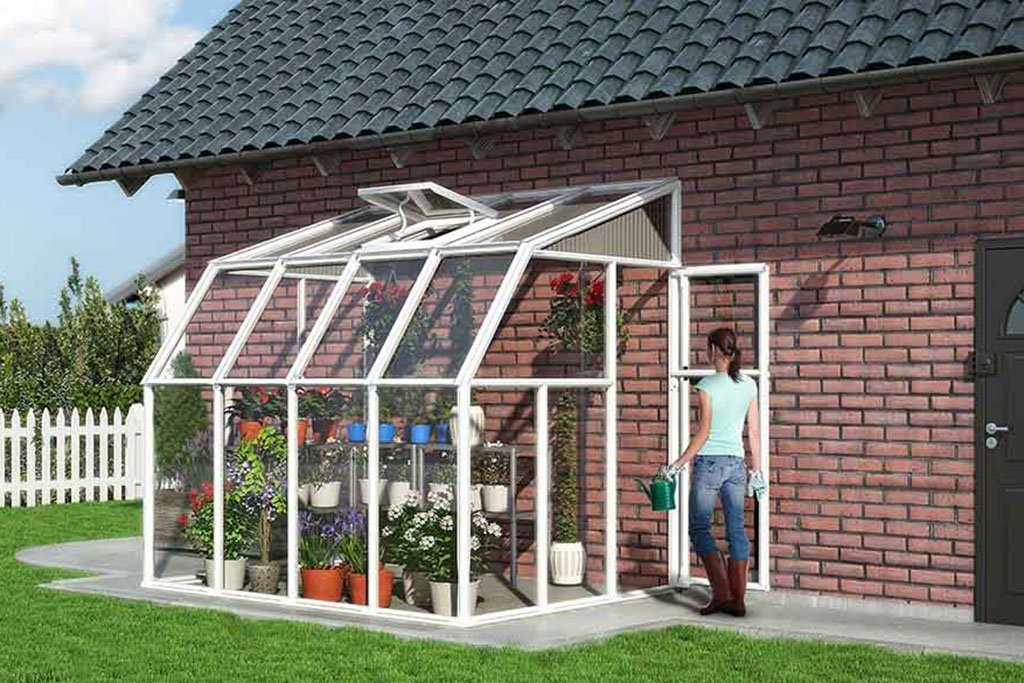
Lean-to greenhouse
Lean-to greenhouses are great solutions for small backyards. They share one wall with your house to give them more stability. It is important to choose a south-facing wall so that the lean-to greenhouse receives sunlight throughout the day.
Window greenhouse
A window greenhouse or garden window is the tiny greenhouse option for your window. It’s an extension for your normal window in order to give your plants more sunlight. The window greenhouse is good for herbs and plants that need more sunlight, but don’t take much room.
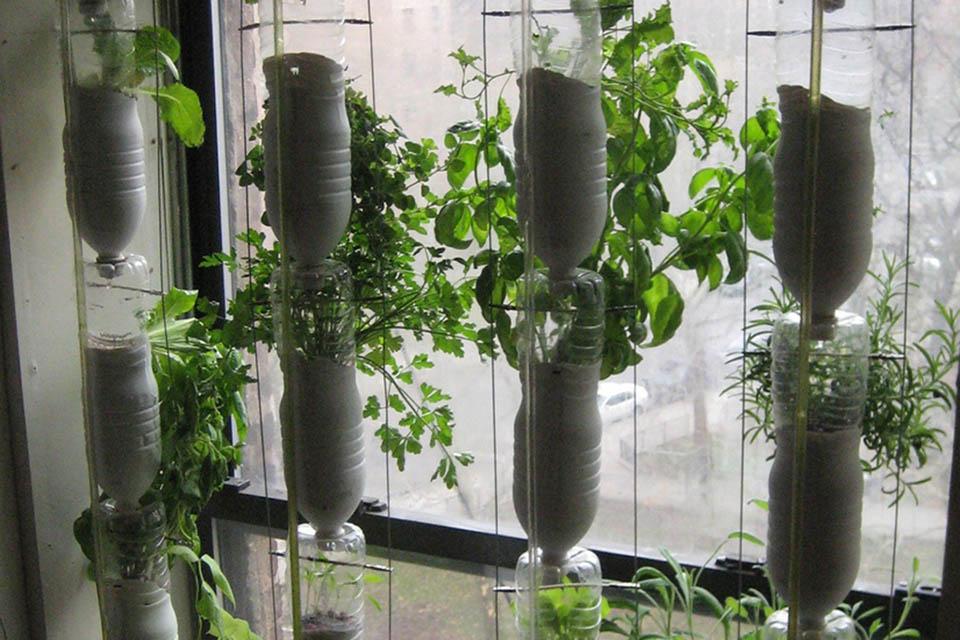
Windowfarm
Using the full potential of the window light, a Windowfarm is a vertical construct that uses the room temperature and an organic “liquid soil” (also seen as hydroponic farming). It is an urban greenhouse solution, completely based on DIY.
Portable greenhouses
After talking so much about solid greenhouse structures, we want to mention the portable greenhouses as well.
The benefit is that you can move the structure with the seasons or for any other reason. Mostly portable greenhouses are cold frames or raised garden beds. However, there are also some small greenhouses that can be moved.
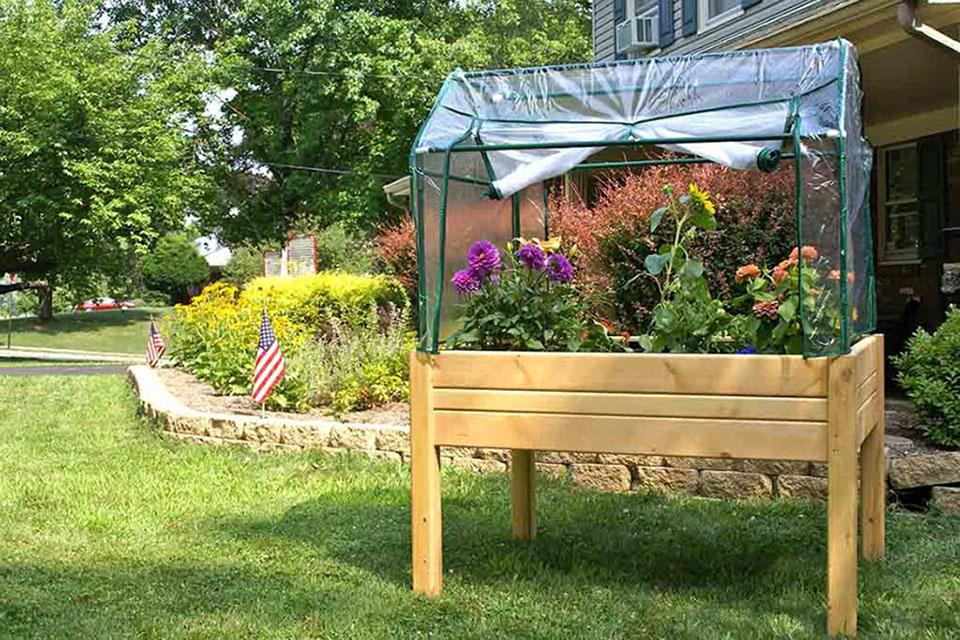
Controlling the basic elements in your greenhouse
As mentioned earlier in this article, a greenhouse allows you to take control over the basic elements in order to protect your plants and provide them the best conditions to grow. However, there are still some tricks to optimize the greenhouse gardening by using the elements to their full potential.
Water – The essence of life
Besides the sun, your plants need water to grow. Proper watering is an essential key to successful greenhouse gardening. As your plants are protected from the rain, you have to find a way to properly irrigate your plants. You can either manually give them water, which is achievable for hobby gardeners with small greenhouses but can take a lot of time. There are also irrigation systems that will do the job for you.
Watering systems for greenhouses
There are basically two types of irrigation systems: Ground and sprinkler systems. Not every plant needs the same amount of water, for example, lettuce doesn’t need as much water as hibiscus. So you want to pair the plants by their water needs and install the watering system accordingly. You can utilize shelves, benches, and racks in order to organize them better.
Hydroponic greenhouses
Hydroponic systems are meant for growing without soil. It normally uses Rockwool or perlite to provide a stable foundation for the roots. The crops are planted in trays on tables that float in the water. So they don’t even touch the ground. Hydroponic greenhouses are not affected by low temperatures in the soil, which makes it a great alternative option for year-round growing as well.
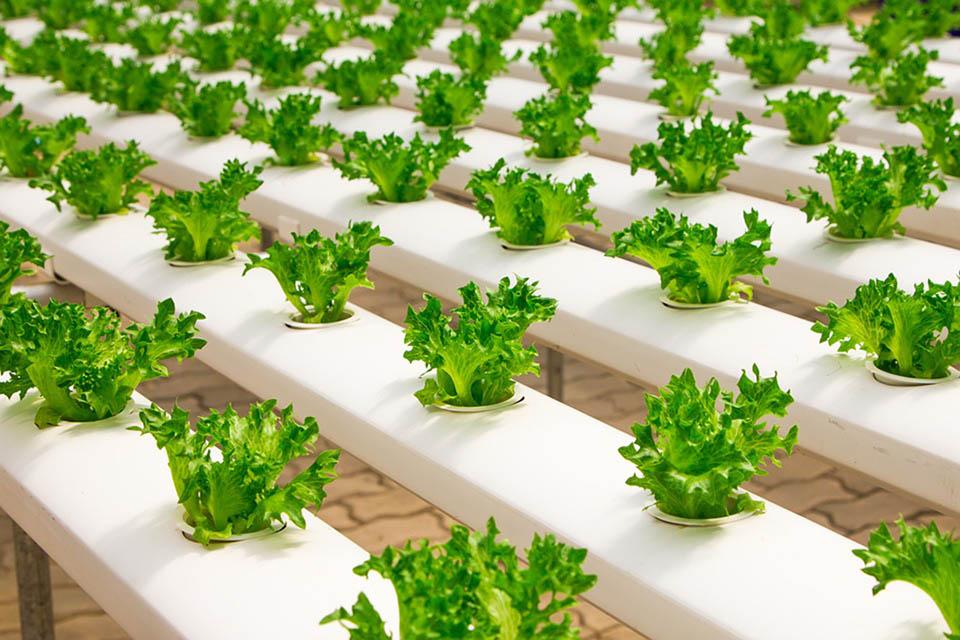
Fire – why the sun is not so easy to control
The sun means power, warmth, but also destruction. While the sunshine is extremely helpful in the winter in order to warm up the greenhouse, it can be the killer in summer (and spring). Therefore you have to utilize it wisely. The positioning of your greenhouse is always the essential key to taking the full advantage of the sunlight.
Position for sun exposure or protection
As the sun will be mostly in the South throughout the day, you want to face the longest side of your greenhouse to the South. This way you can benefit from the necessary sunlight for greenhouse gardening.
If you are living in a climate zone that has hot summers but cold winters, you will be confronted with less sunlight in winters and too much of it in summers. So you have to consider the changing angle of the sunlight in the different seasons, as well as insulate the North side and the roof (mostly done by thicker polycarbonate plastic).
You can also use a shade cloth as an additional accessory in order to protect your plants from too much sunlight. However, it won’t decrease the temperature extremely.
Light deprivation greenhouse
The process of light deprivation (or light dep) forces plants to grow faster because they continuously get sunlight. This is obviously impossible with nature. So farmers use lighting systems to extend the lighting circle, which results in faster growth. It can be used for indoor and outdoor gardening and is very popular for growing cannabis.
Earth – Provide the perfect soil to your plants
Greenhouse gardening makes it easy to provide the perfect soil to your plants so that they can get the maximum amount of nutrients. This also means that you have to pick a good soil, which isn’t easy with all the information found online.
By using separated growing beds and pots, you can adapt the soil to the needs of your plants. If you just want to use one soil for different types of plants, you should choose a balanced mix.
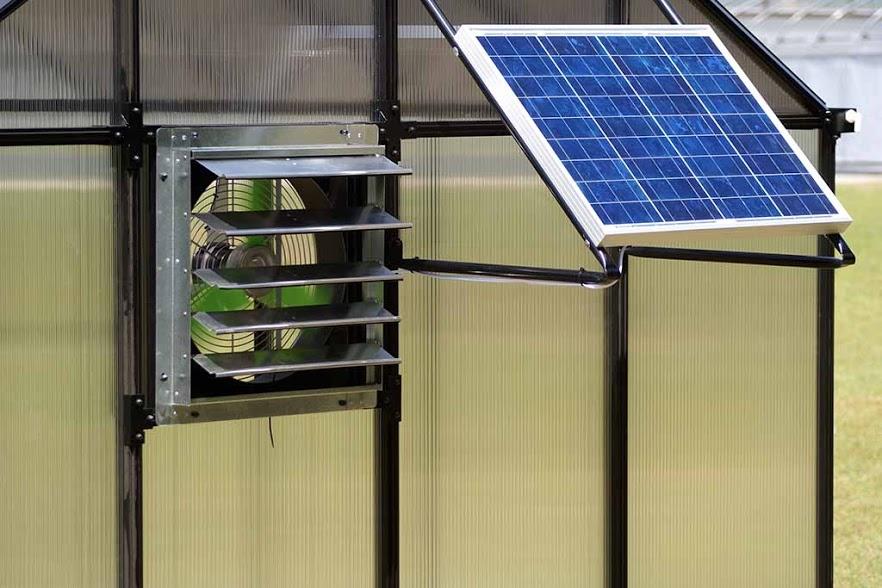
Air – a crucial key to greenhouse gardening
Controlling the air in a greenhouse actually regulates four different areas: Temperature, humidity, CO2/oxygen replacement, and air circulation. If you master the ventilation in your greenhouse, you will be rewarded with healthy crops.
Using a vent or fan can reduce the heat and humidity inside the greenhouse to avoid greenhouse gases (greenhouse effect) because too high temperatures and humidity are counterproductive for plants.
Like us, plants need something to breathe – in this case, it is CO2 and not oxygen. They convert CO2 into oxygen. A good airflow helps to provide enough CO2 for the photosynthesis.
Last but not least, the air circulation ensures that every plant can grow under the same air conditions. It also simulates the wind that they would have in an unprotected environment, which thickens the cell walls of the plant’s stem and is crucial for pollination of certain plants.
Why you should pick your greenhouse carefully?
A greenhouse is a house – in most cases, it’s a permanent structure that you are going to have for several years. You will ultimately have it for 10+ years.
In addition, greenhouse kits are not quite inexpensive if you pick a high-quality brand. So, of course, you have to take your time picking the right one for you.
You don’t want to buy a new one in a couple of years because you realized that you haven’t got enough growing space or that it’s not the right model for your climate or weather conditions.
There are many things to consider and we are here to help you narrow it down. What we have below are the basic things you need to know before purchasing a greenhouse.
DIY or greenhouse kit?
This is a very important question that you have to ask and answer to yourself, and discuss with your partner. It basically comes down to money and skills.
You may choose a greenhouse kit because it is easy to install. If you have fine carpentry skills then you may want to build your own greenhouse because you need a certain size that kits don’t offer. DIY greenhouses can also save you a bunch of money if you can use salvaged materials. But let’s look at all the pros and cons for each type:
DIY Greenhouses
Benefits
- You can salvage building materials anywhere to save money on the materials. You can use anything like windows, wood panels, doors, etc.
- You can do it on a tight budget.
- You can choose your own glazing material.
- You can choose your own design depending on your plans. There may not be a greenhouse kit that meets your dimensions but a DIY greenhouse can.
- It can be a personal achievement. So, it is something you can be proud of.
Disadvantages
- Lots of preparation and structural planning is needed.
- It may take time to build an operational greenhouse.
- Some people don’t have construction supplies like welding materials.
- Supplies may still add up if you buy it new.
- You may need certain tools that you currently don’t have.
- It is not easy to disassemble, relocate, and rebuild when needed.
- Depending on your skills, it may not be able to hold up against wind and snow.
Greenhouse kits
Benefits
- It is easy to assemble. It usually comes with video instructions and manuals.
- You can assemble it in no time.
- All materials are prepared, pre-cut, and ready to install.
- Most kits have basic accessories included.
- It can easily be ordered online and delivered to your curb.
- It has a warranty that often is 10-15 years. This also indicates how long it will last (at a minimum).
- You can choose from a wide variety of designs.
- If you have the funds, you can hire a contractor to set it up for you. No worry, no work, no stress – just sit back and enjoy your already set up greenhouse.
Disadvantages
- It can get expensive.
- You don’t get to customize the size, color, or glazing (in most cases).
- You may have to use brand-specific accessories in order to make the most out of your greenhouse.
What features should my greenhouse kit have?
Greenhouses may look simple but there’s more to it than you think. Depending on your needs and budget, greenhouse kits come with different features. However, some are just very basic. So, let’s take a look at them!
Framework
A sturdy greenhouse framework is key to withstanding the weather. If the frame is made of plastic or other low-quality materials, it won’t hold up against stronger winds and snow loads. It is beneficial if it expects little maintenance.
Aluminum
Greenhouses made with aluminum are economical because they are long-lasting and considered to be low maintenance. They may be more expensive than other frameworks, but it is one of the best investments you can make. It is better than wood, iron, and galvanized steel.
Aluminum frames don’t rot or rust like steel. They don’t degrade from sunlight and in addition they are lightweight and easy to set up.
There are some differences in the quality, though. Some greenhouse manufacturers save money by using as little aluminum as possible. Others, i.e. Riverstone Industries, chose to use more material in order to make the greenhouse framework stronger.
Wood
Wood is a traditional greenhouse framework because of its charming and easy-to-set-up features. It has the advantage of providing excellent insulation. It is best to buy a rot-resistant wood, for example white oak, cypress, redwood, and red cedar. However, keep in mind that wood is working with weather changes. Therefore, it is not as reliable as aluminum.
Galvanized steel
Galvanizing is a method where a layer of zinc is applied to steel to prevent rusting. This improves the strength of the steel frame. It can be pretty heavy compared to aluminum or wood. Galvanized steel is a low maintenance material. It does not require staining and sealing. The costs of these frames are usually less expensive than wood and aluminum.
Doors
Don’t underestimate the benefits of an appropriate door for your greenhouse. Think of your equipment, ease of access, ventilation, and security. This might look like an insignificant detail but it isn’t.
Having a wide door may just be important to people who need to move equipment in and out (i.e. wheelbarrows). Some gardeners may be tall and don’t want to duck or bang their head every time they enter or exit. Higher and spacious doors give you more flexibility. A well thought out design with no door restrictions can mean a lot to any gardener. There are a lot of designs to choose from depending on your needs.
Greenhouse doors can also come in the barn-style design. They have two parts which you can adjust individually or together. For example, you can leave the top portion open to prevent pets and rodents from going inside while keeping a breeze and letting in beneficial insects at the same time.
Vents
A greenhouse will quickly overheat without open vents. It is the best way to release the heat and let in a nice breeze. The number of vents depends on the size of your greenhouse and the climate it will stand in.
Manual vents are the most affordable ones. You need to close and open it on your own, though. There are also automatic vent openers to save the day. It closes and opens depending on the temperature it senses. These are very common in greenhouse kits from various brands. They don’t need electricity to function because they use an oil or wax that expands when reaching a certain temperature. The expansion stretches the arm to open the vent. The contraction of the material closes the vent again.
Base frame or foundation frame
In some cases, it is wise to purchase a foundation frame with your greenhouse kit. It will provide a better protection from wind. You often have different ways to anchor the base frame to the ground, concrete slab, or wood panels. A base frame makes anchoring easier.
If you don’t have much wind or you want to mount the greenhouse in a different way (that is not possible with the base frame), you obviously shouldn’t purchase it.
Insulation factor
Insulation gives advantages in both winter and summer. It keeps the heat inside in winter and it keeps the heat out in summer. Good insulation doesn’t only come from the thickness of the glazing, it also has to do with sealing and how tight it is when assembled. If the panels can move a lot in the frame, they will let in cool or hot air.
Insulation is rated with R- and K-values. While the R-value indicates the insulating capability, the K-value tells you about thermal conductivity. If you are looking for a well insulated greenhouse, you want a high R-value or a low K-value.
What quality of insulation you need depends on numerous factors including the following below:
- The weather where your greenhouse will be located.
- The expense of fuel or electricity to run fans or air conditioning.
- Whether you want to grow certain plants that need a higher temperature year-round, or not.
Factors to consider before buying a greenhouse kit
By now, you already know a lot about the structures and functions of a greenhouse. So it’s time to talk about picking the right greenhouse for your needs. There are, of course, things to consider before buying a greenhouse kit and we are very sure you still have questions about purchasing a greenhouse.
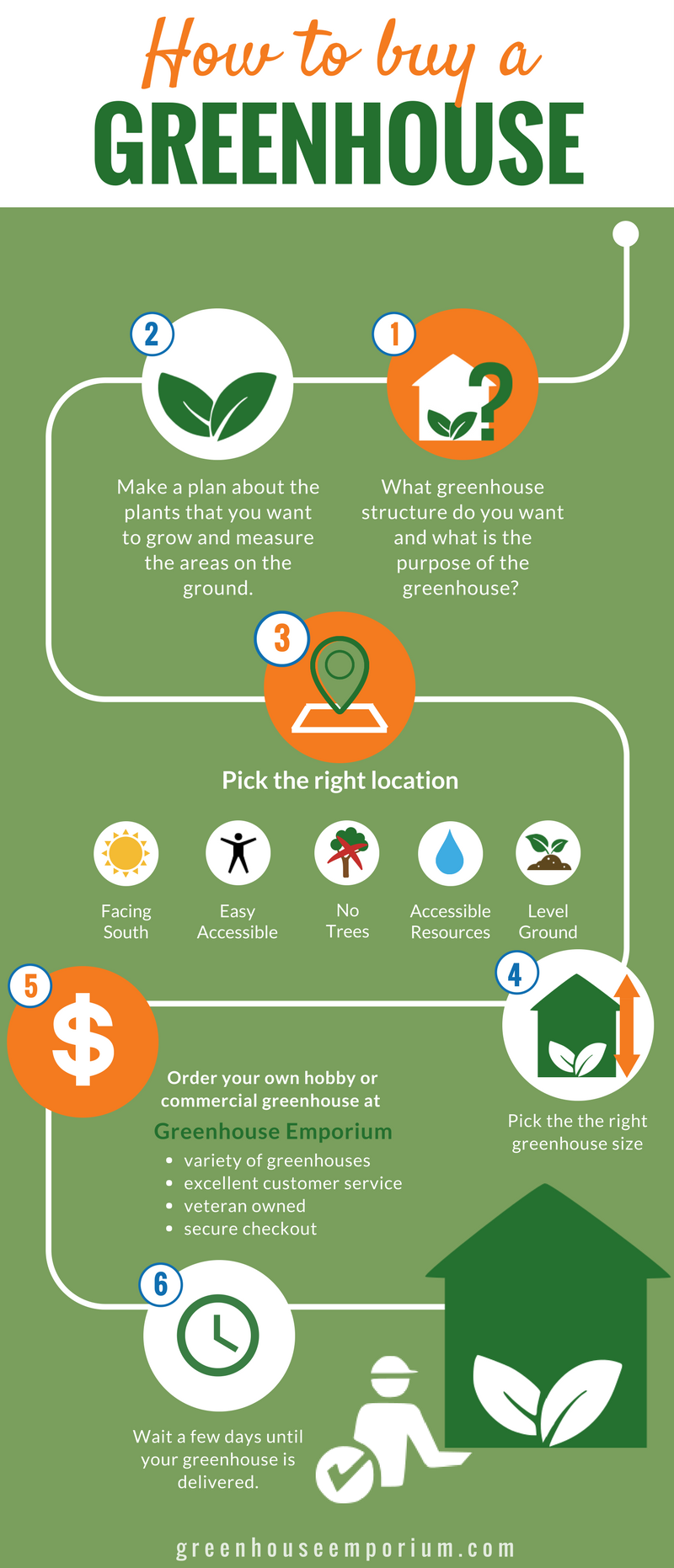
What greenhouse size should I choose?
Pick a size that you think is good and purchase at least one size larger. Why do we say that? Well, most customers regret that they didn’t buy a larger greenhouse. Once you got infected with the ‘greenhouse gardening bug‘, you may want to have more space to grow even more.
This probably is still very unspecific. The size of the greenhouse basically depends on your own needs. How many veggies, flowers, herbs or fruits do you want to plant? For how many people do you want to grow? You will find many sources that give different recommendations. Truth is, you determine the size with your needs and also your budget. So start making a plan by writing down all the plants you want to grow. Then take your time and mark the sections for these plants on the ground. You can place pots or grow bags on the ground to help out. Don’t forget to include a path for you to enter the beds. Read more…
Glass vs Polycarbonate – Which glazing should you choose for your greenhouse?
If you are focused on the looks, you will probably go for the traditional glass greenhouse. Without any doubt, glass looks better. However, glass also has some downsides. That’s why it got replaced with Polycarbonate, which got improved quite a bit over the past decades.
Glass
- Clear panels that blend in with your garden perfectly or allow for a winter garden oasis
- Glass panels are easier to replace locally
- Can fog up, especially if you use hard water for irrigation
- More cleaning to keep the clarity
- High light transmission
- Less protection from extreme sunshine and heat in summer
- Often provides less insulation (especially with 3 mm glass)
- Risk of breakage
- Not as flexible (not possible to have an arched greenhouse)
Polycarbonate
- Sturdy and durable
- More flexible so that it can go on any greenhouse shape
- Very low risk of breakage
- Optimized light transmission (no direct sun) for better plant growth and protection
- Does not yellow anymore
- Easier to maintain: Clean it once a year with soap water, more frequently if you are more concerned
- More variety in thickness, insulation, and light diffusion
- May come with light diffusing properties for optimal plant growth
- Not clear, no matter what some sources say
- Better insulation factors, especially when it’s combined with great framework
- Not as easy to replace a panel locally
Please read our full blog post about glass and Polycarbonate.
Where should I set up the greenhouse?
We already mentioned before that the perfect location for your greenhouse is with the longest side facing the sun (South). This will use the sunlight at its best. If you decide for a small 8′ x 8′ greenhouse, it isn’t important which side is exposed to the sun as it is a square shape.
Here are some more quick tips to consider:
- Avoid trees nearby
- Choose a level foundation
- Good accessibility (for entering, cleaning, and maintenance)
- Access to resources (water and electricity, if needed)
- Good soil (if you don’t use raised beds)
Want more information? – Read this…
Do I need to hire someone to set up my greenhouse kit?
No, you don’t. Generally speaking. Installing your own greenhouse can be very satisfying. Most hobby greenhouses are not that complicated to construct. If you can follow IKEA instructions you probably can assemble a greenhouse kit.
You should schedule at least a whole weekend for the ground preparation and installation. It is best to have some helpers because setting up certain sections demands at least 2 people. Never attempt to do it on your own as a single person. This will just end in a disaster – broken pieces, time issues, and so on (yes, we’ve heard it all).
Ask yourself these questions before making a decision, though:
- Can you manage to work with a manual? You can ask us to send you the manual to check it before making a decision.
- Are you equipped with the tools that you might need?
- Are you fit to use power tools?
- Are you fit to lift heavy materials?
- Can you be a jack-of-all-trades to perform tasks like framing, fixing a door, or fitting a vent?
- Do you have helpers that have time for this project?
- Can you dedicate enough time for preparing the ground and assembling the greenhouse?
If you don’t think that you can manage the installation, contact a local contractor. They should be able to help you out. Get a quote from them before purchasing the greenhouse kit.
Do I need a building permit for setting up a greenhouse?
The last thing you need is having trouble with the local requirements. As every community handles these things differently, we cannot give an exact answer. However, it is fairly easy to find out yourself.
You have to take care of two requirements: Zoning & Building Permit. The Zoning Permit regulates the location of your greenhouse in your garden, e.g. the distance between the lot line and greenhouse. So check with your local zoning department for further information. Then check with your state building department for a potential Building Permit. Some states have to accept the structural integrity and the physical appearance. However, they usually consider a greenhouse as a temporary structure so that you won’t need a Building Permit. The best way to find out is to ask them, though.
Do you need greenhouse accessories?
The simple answer is no. You can grow plants with standard greenhouse kits. However, certain accessories may be beneficial for your specific climate or for using it the most efficient way.
- Hot climate: you may need a shade cloth, more ventilation, a misting system, or a swamp cooler
- Cold climate: you may need a heat source (DIY or space heater) – Read this for more information.
- Shelves, hangers, & pots: they help you stay organized and to make the most of your available growing space.
- Watering systems: only really necessary if you can’t do it on your own and then drip irrigation is generally the better choice. Misting only makes sense if you grow plants that like it or if you have very hot summers.
- Grow lights: only necessary if you want to grow certain plants, as well as in winter with shorter daytime.
- Ground cover: Very useful in order to keep weeds away. You can buy a cover or use old newspapers.
- Flooring: Not necessary but convenient for better footing.
Where should I buy a greenhouse?
You can buy greenhouses in a physical store, such as Home Depot, or in an online shop like Greenhouse Emporium (that’s us).
While a physical store only has a few different greenhouses in stock, our online shop offers a variety of vendors and sizes, as well as accessories. We ship right from the manufacturer and can walk you through the whole process from finding the right greenhouse over purchasing and receiving the greenhouse kit.
We are using secured payments so that there is nothing you have to worry about.

